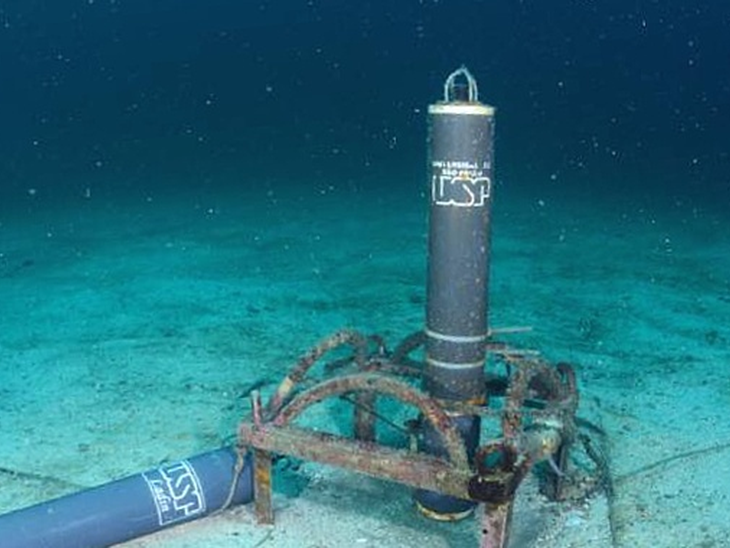
T&B Petroleum/Fapesp

In order to perform acoustic monitoring of gas leaks on the ocean floor, some tens of thousands of meters deep, researchers from the Research Center for Gas Innovation (RCGI) - an Engineering Research Center (CPE) constituted by FAPESP and Shell - are setting up an unprecedented database at the Polytechnic School of the University of São Paulo (Poli-USP).
The collection of acoustic data, as well as the hardware and software that are under development for the collection and analysis of sounds, is linked to another initiative of the research center aimed at analyzing the feasibility of building caves in layers of rock on the pre-salt layer . These caves would be used to store carbon dioxide (CO2) after the separation of natural gas. The proposal is that the database generates subsidies to monitor possible CO2 leaks in this type of reservoir (read more at agencia.fapesp.br/29037/).
The repository consists of material obtained in the field and in the laboratory. It is constantly growing and currently totals approximately 60 hours of recording. The researchers recorded the sounds of bubble plumes originating from simulated gas leaks under water, at different flows, pressures and locations.
“Leaks generally form a plume of bubbles that make a noise when generated under water. Our goal is to know the 'signature' of the noise of these plumes in order to be able to detect, quantify and differentiate them from other types of noise ”, Professor Linilson Rodrigues Padovese, project coordinator, told the RCGI Communication Advisory and also from the Acoustics and Environment Laboratory (Lacmam) of the Mechanical Engineering Department of Poli-USP.
The team began to collect experimental data on leaks in order to validate the artificial intelligence algorithms developed for the detection of these phenomena. “We did leak simulations to obtain the data. There were three outings in the field, two at sea and one at a dam, and we were able to progress a lot in the database. We also use the laboratory tank installed at Poli and, also, the CEPE-USP [USP Sports Center for Sports] diving tank. We already have a good database, with different sizes of bubble plumes and for different flows. ”
To simulate the leaks, the researchers used a compressed air reservoir and hoses, with instrumentation to control air pressure and flow and with outlet orifices of different diameters. “For each recorded sound, we know what the air flow was. When simulating leaks, we already stipulated the flow: for example, one liter per minute; 10 liters per minute. Thus, we know the plume signature for each flow, for each flow that we establish. In other words: we have data to establish comparisons. ”
New challenges
According to the professor at Poli-USP, the detection of noise from bubble plumes is no longer a problem. “We are already sure that we can detect and differentiate flow rates of 2.5 to 10 liters per minute up to 40 meters in depth. The challenge now is to have a pilot project to test the methodology, software and hardware in conditions similar to those of the desired application. We need to assess whether the conclusions we have drawn so far are applicable to greater depth. ”
The engineer explains that both a leak and the passage of a ship, for example, can change the sound background of the seabed. Only the noise of the ship passes in a few minutes, while the leak remains. So, as time goes on, confidence increases that that noise may actually be a leak.
“I really believe that, in terms of noise analysis, it will be easier in the depth conditions of the salt caves, because it is quieter down there. At 2 thousand meters deep, the acoustic noise is more homogeneous, that is, it is easier to detect something that should not be there, such as a leak. When we went to the sea, we did the experiments near the port of Santos and there is everything: dredger, big ships coming in and fisherman's boat passing by. Therefore, we believe that, if we can detect a leak in these conditions, at great depths it will be even more favorable. ”
According to Padovese, a leak is unlikely to generate just a plume of bubbles. “We will probably have a set of feathers, which makes a bigger noise. I would say that conditions at great depths will be more favorable, although, from the point of view of the hardware used to capture the noise, more demanding. But this is an engineering issue. ”
Funding strategies
The professor explains that, to monitor underwater salt caves, an equipment option that the laboratory is developing is a stand-alone recorder, called by them the OceanPod. It is a cylinder (made of PVC, aluminum or stainless steel, depending on the depth at which it will be placed) that contains a recorder, signal conditioners, hydrophone and batteries, allowing autonomy of up to six months. According to him, the big question now is regarding the “sowing” of sound capture equipment on the marine soil.
We will not only work with an OceanPod, but we will sow an area with some of them. Because the leak can seep through [the] geological structure of the cave at any point. Therefore, it is necessary to sow the equipment in the area that supports the cave. But the distance between one piece of equipment and another is something we're still working on. One must be at the limit of the other's coverage, so that there is no blind spot. ”
The researcher points out that several monitoring strategies are possible. The choice must be made by the project team dedicated to designing the salt caves and studying their feasibility.

Contact us